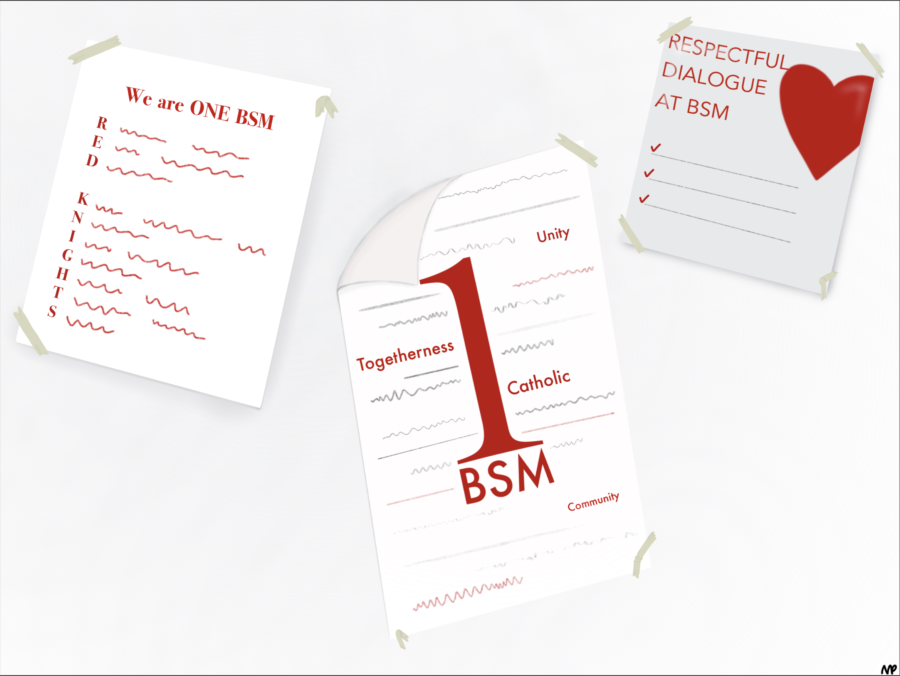Staff Ed: Are We One BSM?
The “One BSM” initiative seeks to unite students as one cohesive body and is consistently advertised around the school.
In all likelihood, you have heard the phrase “One BSM” at some point this year whether it be in an announcement from the administration or jokingly in conversation with your peers. Yet the question remains: is “One BSM” uniting at all?
The underlying purpose of the program is undoubtedly necessary. As a microcosm of the world we live in, BSM too has its struggles with diversity, equity, and inclusion (DEI). Thus, an initiative designed to unite a divided community is theoretically perfect. The administration is not blind to these issues and has made efforts under the “One BSM” initiative to better incorporate the larger BSM community.
The head of the initiative and the Director of Diversity, Equity, and Inclusion, Dennis Draughn, has expressed an interest in hearing from students. He sent out a form titled “Culture and Climate Student Survey” at the end of January asking for feedback on whether or not students feel adequately heard, supported, and respected. Furthermore, he mentioned positive aspects of “One BSM” that have been proposed by students such as the culture and heritage fair where students will have the opportunity at the end of April to showcase and celebrate their background and identity. “If students have any ideas on how to bring us together… by all means, bring them to me and I will advocate for you and make sure that this gets done to the best of my ability,” Draughn said.
Additionally, BSM educators and six sophomore students had the opportunity to attend the People of Color Conference held by the National Association of Independent Schools, which brought together students and faculty from schools across the country. Having spoken to attendees of the conference from BSM, the reaction was extremely positive and profound. “It’s pretty powerful to see so many different races and nationalities coming together all under one roof for a common goal and common purpose, so that was really powerful… Several of the workshops I attended were really profound and transformative as well,” Keanan Faruq, an attendee of the conference, said.
After attending the conference, students and teachers met with the administration to discuss their key takeaways from the event. Faruq emphasized the administration’s receptiveness to their suggestions for BSM that they drew from the conference. “The reception and feedback that I personally have gotten from administration has been incredibly positive, and [I’m] just really excited for us to put some of these teachings into practice sooner rather than later,” Faruq said.
However, with such a complex and pervasive issue, we must constantly be evaluating whether or not adequate measures are being implemented consistently to uphold DEI. So the question remains: is “One BSM” actually uniting? While positive changes have been made, the initiative has failed to fully address disparities among minority students.
Perhaps the greatest solution to division is conversation, but we continue to shy away from discussing difficult topics. We are told to practice “respectful dialogue” but are rarely given the opportunity to engage in a serious conversation where respect is necessary. When teachers dare broach the subject of racism, sexism, ableism, homophobia, etc., the class sits in painful silence. Subsequently, these topics are often discussed in sweeping generalizations that fail to include multiple perspectives and shades of nuance or they are ignored entirely–neither of which are satisfactory solutions. By no means is this said to fault the teacher, but rather it is a critique of the way we approach the subject matter as a whole.
Sometimes, “One BSM” has become a statement that doesn’t unify as it intends. In trying to bring students together, the initiative has instead painted the student body with one broad brush. This loss of individuality is perfectly encapsulated in the removal of homecoming t-shirts. In years past, each grade level had different colored shirts to build camaraderie among students. However, they were removed this year because they were deemed “too divisive.” The problem is not with a bit of intergrade competition and demonizing such only trivializes the greater issue.
How can we as a school claim to foster development if students are not given the opportunity to think for themselves? We can’t. We can potentially claim dictated conformity, but this does not adequately promote growth. This loss of individuality goes back, again, to the lack of conversation. Students who can’t think for themselves cannot discuss serious issues. If there is no discussion, there is no solution. And the cycle continues.
The greatest solution also happens to be the greatest concern. In the five months since its implementation, there has been little consistent opportunity for feedback. It is unfair to assume that the administration has as great of a pulse on how “One BSM” is perceived as students. Yet, they have failed to tap into this large resource.
Students who attended the People of Color Conference expressed a need to establish opportunities for judgment-free dialogue about serious issues. At the conference, attendees broke into smaller groups or “safe spaces” that sought to incorporate everyone into discussion about select, complex topics. Those who participated emphasized how there was a clear understanding that each individual was to be respected and heard even if there was disagreement. “There [were] a lot of safe spaces, so no matter what group you [were] in, you felt comfortable to share what you [were] going through and your experiences… I think that’s really important to grow as a community,” Lyra Carter, a student attendee of the conference, said.
One aspect that was consistent among all conference attendees we spoke to was the absolute necessity to recognize each individual as valuable contributors to the community. “Everyone’s different. Everyone has something important that they can bring to the table [and has] different perspectives… We just need to try and hear that from each other,” Raphael Johnson-Nixon, a student attendee of the conference, said.
An opportunity for discussion could be pulled from the past. A few years ago, there was a principal student advisory group that met monthly to discuss current issues at BSM as well as proposed solutions to these problems. Since COVID-19, this program has been disbanded with nothing to replace it. Reinstating this group and modifying it to focus on DEI could be a way to set up an organized outlet for feedback involving students, administrators, and current issues.
Additionally, a greater emphasis on individual development rather than forced conformity is essential to recognizing the human dignity we claim to uphold. Changing the discussion of literary characters to focus more on each individual’s strengths and weaknesses is a tangible educational change that can be made to teach the celebration of individuality and diversity. “The power of perspective when reading a book or discussing literature, character and literature, is that as individuals, as readers, as the audience, we can start seeing ourselves a little more clearly in the books that we read and the characters that we discuss… Maybe there’s multiple paths to success. Maybe there are multiple definitions of what success means. And it’s absolutely okay to find your own way, rather than just saying there’s one way to make it in America,” Faruq said.
No matter the formal or informal nature of it, conversation and feedback are undoubtedly needed. Without it, DEI disparities will persist and division will continue. A two-word slogan isn’t enough. Further action needs to be taken, feedback needs to be considered, and individuality needs to be celebrated.




































![Teacher Lore: Mr. Hillman [Podcast]](https://bsmknighterrant.org/wp-content/uploads/2025/03/teacherlorelogo-1200x685.png)





